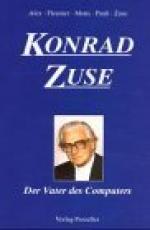|
This section contains 319 words (approx. 2 pages at 300 words per page) |
World of Invention on Konrad Zuse
Konrad Zuse was the designer of the first operational, fully electronic, program-controlled, general-purpose computer. He created the computer in Germany in 1941, but the machine was largely unknown until the 1960s.
Zuse was born in Berlin and studied engineering at the Berlin Technical School. Interested in speeding up mathematical calculations, Zuse designed a device similar to that developed by the nineteenth century English computer pioneer, Charles Babbage, whose work was unknown to him. After graduating in 1935, he went to work for an aircraft company, spending his weekends building a computer (the Z1) in his parents' living room. From the beginning, Zuse's design used binary numbers and he wrote his instructions in logical form, using and, or, and not. Instructions were punched on movie film. For memory, the Z1 used slotted metal plates with pin positions in the slots representing one or zero.
Zuse's employer provided the resources for his Z3 model, which he completed in December 1941. The Z3 featured floating point arithmetic (for varying decimals), was fully operational, and used electric telephone relays (on-off switches) for computing operations. It used 1,800 relays for memory, 600 for computation, and 200 for input-output. The Z3 was destroyed in a 1945 air raid during World War II.
In 1949, Zuse set up Z4 at the Technical School (ETH) in Zurich, Switzerland, later moving it to Basel where it continued to operate until 1959. He then founded his own computer-manufacturing company, Zuse AG, which designed and produced a series of innovative specialized computers. In 1958 Zuse designed a parallel processor (able to perform several operations at once) for differential equations. In 1969, Zuse sold his company to the large computer manufacturer Siemens AG.
Zuse also devised a computer language, Plankalkul, that could be used for both numerical and non-numerical problems, including programming chess games. In 1966 he became a professor at the University of Gottingen, Germany. Among his numerous honors is a medal from the American Federation of Information Processing Societies.
|
This section contains 319 words (approx. 2 pages at 300 words per page) |


